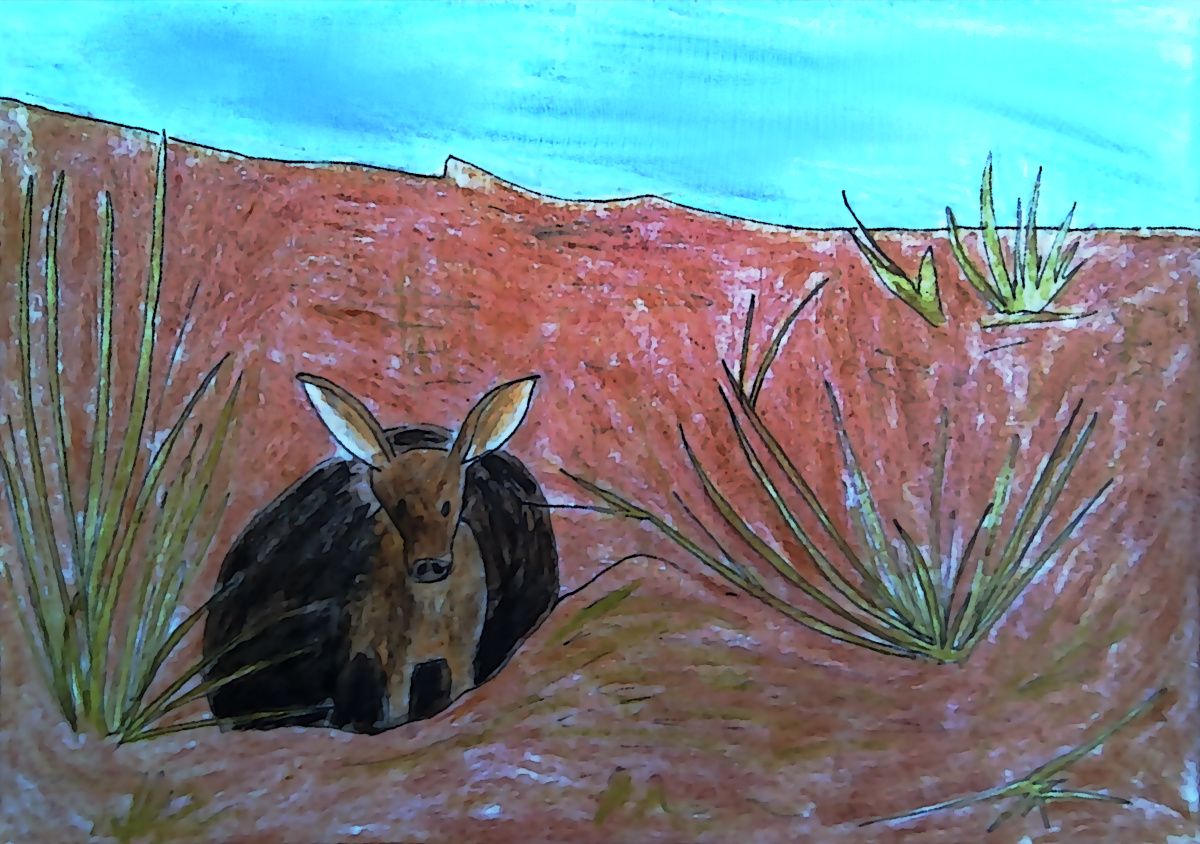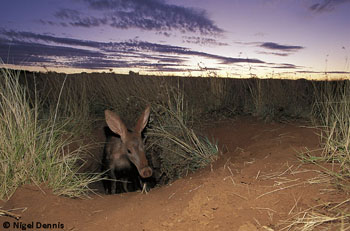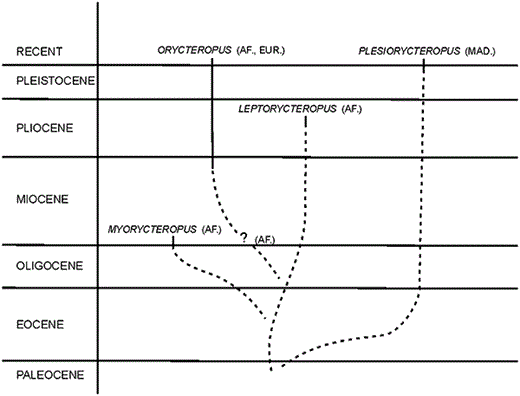An aardvark’s night out — and a look into its ancestry.Four hours after sunset, in a patch of dry savanna in Sub-Saharan Africa, an aardvark emerges from the south entrance of its burrow. It turns and looks back at it with pride. This subterranean network of chambers is its own handiwork. It has sculpted the labyrinthine interior with its powerful claws, and has carved out a new chamber in the past month. The aardvark leaves its abode and roams the plains of the savanna looking for termites and ants. But it is not the only one looking for food. Its rabbit-like ears pick up a rustling in the nearby overgrown vegetation to the west. Remembering this sound from a lion that it had narrowly escaped, it turns and heads east. As our lone mammal travels across the dry expanse, it swings its snout from side to side, hoping to detect the scent of termites or ants. After a half-hour of searching, it picks up a scent and soon finds a termite mound protruding up from the ground. It digs into the ground to unearth their stronghold. Once it spots the little bugs, it extends its 12-inch-long tongue. Within seconds, it slurps up hundreds of termites.
I have always found the aardvark to be a unique and fascinating creature. The word “Aardvark” is Afrikaans for “earth pig”. Also known as the “ant bear”, this beast is the picture of solitude — not only because it is a lone creature that is rarely seen with its kind, but because it is literally in a class by itself from an evolutionary standpoint. A nocturnal creature, the aardvark can eat as many as 50,000 insects in a night. This nightly feast is aided by the fact that it usually hunts alone. Typically, two aardvarks will only come together for mating before proceeding their separate ways. Tracing the evolution of the aardvark has been quite a puzzle. This is in large part because of its unique appearance and lack of close living relatives. In earlier times, scientists thought that the aardvark was closely related to the anteater. This was back when all we had to go on were physical characteristics, eating habits, and morphology. Like the anteater, the aardvark is a mammal, has a long snout, and consumes insects. That said, the two exist on different contents — while the anteater lives in South and Central America, the aardvark takes up residence in Africa.
Nourished but not yet satisfied, our thin-furred creature soon leaves the mound and moves on in search of other snacks. It finds another mound across from a large patch of overgrown shrubs and tall grass. Nearby it hears a rustling sound, this time closer than earlier. Glancing behind, it spots movement in the tall grass and turns to face it. In the dim moonlight, the ant bear catches a glimpse of more rustling — perhaps a tail, though with its poor eyesight, it can’t quite make it out. Suspecting a threat, it whips around and moves away from the grass, intending to try another area. The foraging will have to wait. Within seconds, a hyena emerges from the tall grass. Our traveller turns and breaks into a brisk trot. The predator begins to approach, its head confidently bobbing up and down. As the aardvark picks up the pace, the hyena lets forth a quiet snarl and accelerates as well. Within seconds, the ant bear’s brisk trot breaks into a frantic scramble. Both race over the grassland at around twenty miles an hour, and the hyena is closing in.
Known formally as Orycteropus Afer, the aardvark is the only living member of the Oryctopodidae family. Fossil clues suggest that there are 14 different species in the aardvark family that all went extinct. It is also the only extant member of its mammalian order Tubulidentata, which means tubule-toothed. Its closest relative, Leptorycteropus, has been extinct since the late Pleistocene age. The notion of the aardvark’s relatedness to the anteater was soundly refuted by molecular studies, which allowed scientists to get a close-up look at protein molecules. These chains of amino acids are constructed based on the instructions within DNA, and particular protein sequences can be compared across species. One of these proteins was an eye lens protein, known in scientific circles as α-Crystallin A. Differences in the amino acid sequences of this protein revealed that the aardvark was most similar to the manatee, the hyrax, and the elephant — but it was found to be quite unrelated to the anteater. The aardvark has many adaptations. It has a thick hide, which helps to protect it against the bites of the insects it feeds upon. Its long snout is well-suited to eating ants and termites. And its sticky tongue can be as long as twelve inches, which allows it to reach into holes and capture its prey. The aardvark also has sharp claws and powerful front legs, which it uses for burrowing. With its power and speed, an adult can dig a tunnel one metre in length through densely-packed earth in just five minutes. Its legs are also useful for escaping from predators.
The long-snouted animal races into a wooded area, moving in a zig-zag fashion and around trees to avoid its aggressor. As it negotiates the surroundings, it collides with an old acacia tree, causing a large branch to fall to the ground behind it. The hyena leaps over the fallen branch and keeps racing towards its target. The aardvark moves left, then darts right. Confused, the hyena collides with a thorn bush. It rises growling and resumes its pursuit. Our plucky insectivore gains a little ground and finds that the forest opens up into a large glade in a wooded area. It recognizes this place and starts to amble towards a sunken patch of dirt near the centre of the glade. It is barely able to catch its breath when the hyena emerges from the trees. The hungry creature ploughs into the glade, leaving a thick trail of dust behind it, and rushes at the aardvark, tackling it to the ground. The two wrestle for several seconds, causing a thick cloud of dust to swirl around them. The hyena tries to trap the aardvark with its hind legs and left foreleg, pressing it next to the sunken indentation it was looking at. The hyena opens its mouth and swipes at the aardvark with its right claw.
While the aardvark has been an evolutionary enigma for quite some time, its phylogenetic relationships have become somewhat clearer with advances in molecular genetics. Its adaptations enable it to survive the deserts and savannas of Sub-Saharan Africa. I have long found the aardvark to be a fascinating, lovable oddity. It is considered a keystone species, not least because it creates living spaces for other members of its community. An aardvark resides within the burrows that it creates with its digging. Some of these burrows end up being vast networks of tunnels, while others are small outposts created for foraging. Aardvarks may leave old burrows and move elsewhere to create new ones — and the burrows it abandons may end up as homes or resting places for other animals, including snakes, lizards, wild dogs, and warthogs. While the aardvark’s first instinct on hearing a predator is to flee, it can also fight back using its sharp claws and strong tail and shoulders. When completely trapped, the aardvark is known to roll over onto its back, lying motionless except for its claws which turn into a fighting machine. Needless to say, this strategy is only used as a very last resort.
Before the aggressor can make contact, the gritty ant bear squirms out of its grip and quickly digs at the sunken patch of dirt, revealing a large hole in the ground. It escapes into the narrow opening head-first. As the cloud of dust settles, the hyena looks down the hole for a few seconds and sees empty blackness. It then looks up, dismayed and dejected. Scratching the ground with its left claw in frustration, it turns its head swiftly and trots off into the night. The aardvark breathes a sigh of relief and collapses on the cold dirt floor for a few minutes. After this brief rest, it then gathers its strength, stands up, and inspects the tunnels it had carved one year before. It wanders through its tunnels and sees that several chambers have new inhabitants. In this chamber is a warthog asleep. Resting in the next chamber is a wild dog. And creeping quietly in a dusty corner is a small, green lizard. The lizard and ant bear lock eyes. While the lizard evaluates the possible threat, the aardvark takes its look as silent recognition of its narrow escape. Breaking eye contact, it keeps moving down the corridor. The long-eared mammal finds an empty chamber in the fast network of tunnels and takes a nap, biding its time until it is sure the hyena has moved on and will not return. While its earlier meal was but a snack, it knows it will be resuming the hunt soon.
The Author's Notepad Nevin Katz
This week, due to the success of the previous round, we're having another go at author notes! While writing this article, Nevin came across many interesting pieces on related topics, the best of which are listed for you below:
📯 Spread the word! The more subscribers we have, the more sustainable we get—and what better person to spread the word than you, the happy reader? If you enjoyed this article, here's your challenge for the week: send this piece to three people directly, and share it with one forum or groupchat. Like the aardvark's hollows, there's empty spaces there waiting for you to fill them with a bit of literary non-fiction! |




